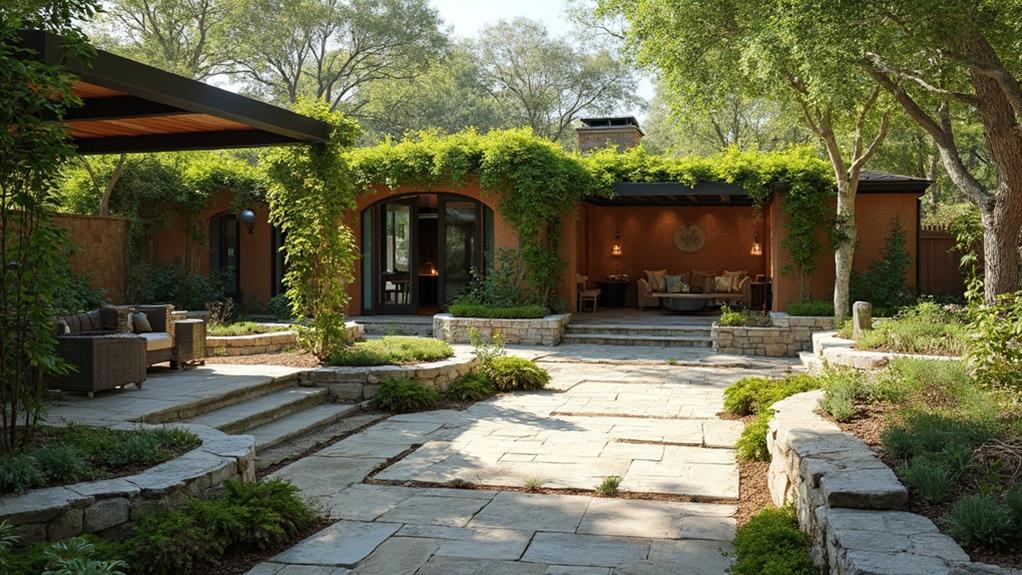Backyard micro-climates are small-scale environmental zones with unique temperature, humidity, and wind patterns. By understanding these zones, homeowners can optimize their outdoor spaces for year-round comfort. Identifying warm and cool areas allows for strategic landscaping decisions, such as planting deciduous trees for shade or installing windbreaks. Water features like fountains or ponds can provide cooling effects, while heat-absorbing materials create cozy spots for cooler evenings. Proper placement of outdoor structures and seasonal planting strategies further enhance comfort. By leveraging micro-climate knowledge, you can transform your backyard into a versatile living space that adapts to changing seasons and weather conditions.
Understanding Backyard Micro-Climates
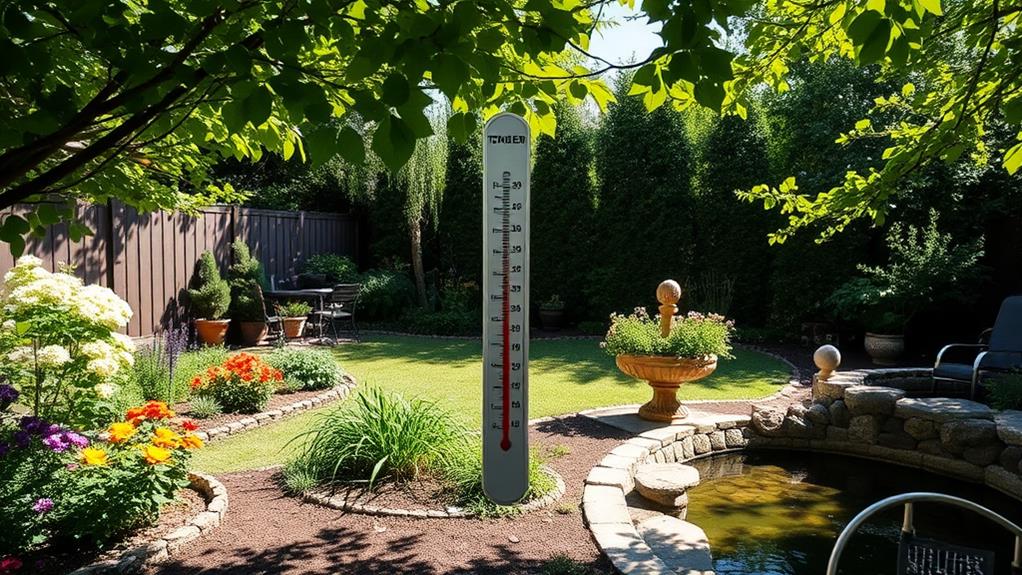
Tucked away within the confines of your property, backyard micro-climates are small-scale environmental zones that differ from the surrounding area. These unique pockets of varying temperature, humidity, and wind patterns can significantly impact plant growth, outdoor comfort, and energy efficiency. Factors such as topography, structures, water features, and vegetation contribute to the formation of these distinct zones.
Understanding backyard micro-climates is crucial for effective landscape design and outdoor living space optimization. Sunlight exposure plays a pivotal role, with south-facing areas typically receiving more warmth and light than their north-facing counterparts. Wind patterns, influenced by buildings and fences, can create sheltered spots or funnel breezes through specific areas. Moisture levels vary based on proximity to water sources, drainage patterns, and soil composition.
Identifying these micro-climates allows homeowners to make informed decisions about plant selection, outdoor furniture placement, and climate control strategies. By leveraging natural advantages and mitigating unfavorable conditions, you can create a more comfortable and sustainable outdoor environment. This knowledge forms the foundation for targeted renovations that enhance your backyard's usability and appeal throughout the year.
Identifying Warm and Cool Zones
With a foundational understanding of backyard micro-climates, the next step is to identify specific warm and cool zones within your outdoor space. This process involves careful observation and analysis of various factors that influence temperature and comfort levels.
To identify warm zones, look for areas that receive direct sunlight for extended periods, particularly south-facing spaces. Surfaces that retain heat, such as concrete patios or dark-colored structures, often create warmer microclimates. Areas sheltered from wind by walls, fences, or dense vegetation tend to be warmer as well.
Cool zones are typically found in shaded areas, especially those on the north side of buildings or under large trees. Places with good air circulation or near water features often maintain lower temperatures. Low-lying areas may also be cooler due to cold air settling.
Use tools like infrared thermometers or temperature loggers to accurately map temperature variations across your yard. Observe these patterns throughout different times of day and seasons to gain a comprehensive understanding of your backyard's thermal landscape. This information will be crucial for strategic renovations to enhance comfort year-round.
Landscaping for Temperature Control
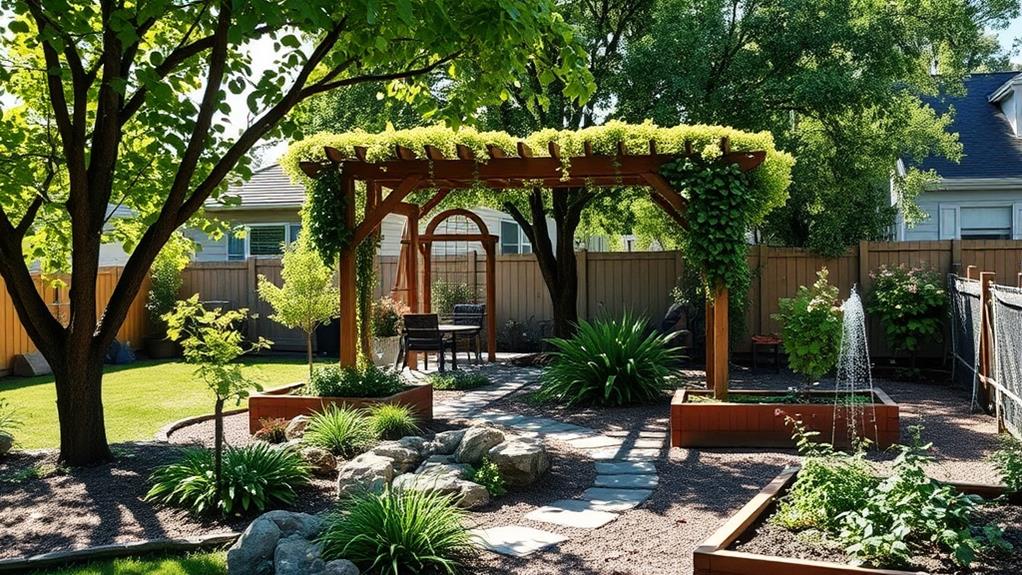
Landscaping strategically can significantly influence the temperature dynamics of your backyard micro-climates. By carefully selecting and positioning plants, trees, and hardscaping elements, you can create cooler areas in summer and warmer zones in winter.
To reduce heat in summer, plant deciduous trees on the south and west sides of your property. These provide shade during hot months and allow sunlight through in winter when leaves fall. Install pergolas or trellises with climbing vines for additional shade. Use light-colored, reflective materials for patios and walkways to minimize heat absorption.
For winter warmth, plant evergreen trees as windbreaks on the north and northwest sides. This helps deflect cold winds and reduce heat loss. Create sun traps by positioning walls or fences to capture and retain solar heat. Incorporate heat-absorbing materials like stone or brick in south-facing areas to store warmth during the day and release it at night.
Water features can cool surrounding air through evaporation. Consider installing a pond, fountain, or misting system in areas prone to overheating. Lastly, use mulch in garden beds to regulate soil temperature and retain moisture, further stabilizing your backyard's micro-climate.
Wind Breaks and Shelters
Effective wind breaks and shelters play a crucial role in creating comfortable micro-climates within your backyard. These structures can significantly reduce wind speed, protect plants from damage, and enhance outdoor living spaces. When designing wind breaks, consider using a combination of trees, shrubs, and fences to create a multi-layered barrier that filters rather than blocks wind completely.
For maximum effectiveness, wind breaks should be positioned perpendicular to prevailing winds. The ideal height for a wind break is typically 1.5 to 2 times the height of the area you wish to protect. Dense evergreens like spruce or cedar make excellent natural wind breaks, while deciduous trees can provide seasonal protection.
In addition to wind breaks, consider incorporating sheltered areas into your backyard design. These can include pergolas, gazebos, or strategically placed walls to create protected spaces for relaxation and outdoor activities. When planning shelters, factor in sun exposure and airflow to ensure comfort in different seasons.
Water Features for Cooling
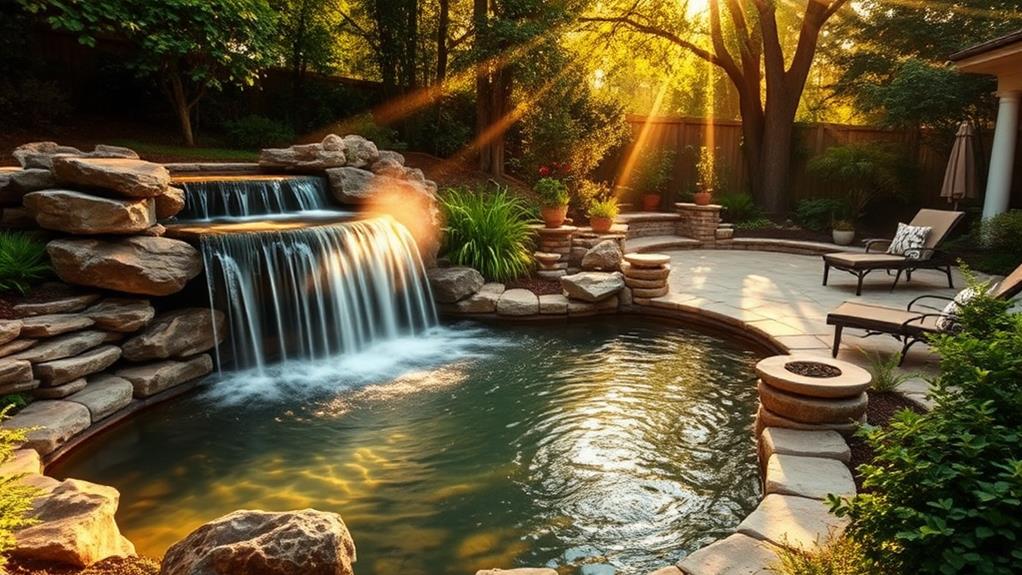
Beyond aesthetic appeal, water features serve a practical purpose in creating cooler micro-climates within your backyard. As water evaporates, it absorbs heat from the surrounding air, effectively lowering the ambient temperature. This cooling effect can be particularly beneficial during hot summer months, making outdoor spaces more comfortable and inviting.
Various water features can be incorporated to achieve this cooling effect. Fountains, for example, not only provide a soothing sound but also increase water surface area for enhanced evaporation. Ponds or small pools can act as heat sinks, absorbing excess warmth during the day and releasing it slowly at night. Strategically placed misters or water walls can create a fine spray, instantly cooling the air as droplets evaporate.
When designing water features for cooling, consider factors such as size, placement, and water circulation. Larger features generally offer more significant cooling effects, while proper positioning can maximize air flow and temperature reduction. Incorporating aquatic plants can further enhance cooling through transpiration. Additionally, moving water, as in streams or cascades, increases evaporation rates and provides a pleasant auditory element to your backyard oasis.
Heat-Absorbing Materials and Surfaces
Selecting appropriate materials and surfaces for your backyard can significantly impact its microclimate. Heat-absorbing materials play a crucial role in regulating temperature and creating comfortable outdoor spaces year-round. Dark-colored surfaces, such as asphalt or black concrete, absorb and retain heat more effectively than lighter alternatives. This property can be advantageous in cooler climates or during winter months, as these materials release stored heat gradually, warming the surrounding area.
Conversely, in hot climates or summer seasons, minimizing heat absorption becomes essential. Light-colored or reflective surfaces, like light concrete, pale stone, or specially designed cool pavers, can help reduce heat buildup. These materials reflect more sunlight, keeping the area cooler. Additionally, permeable surfaces like gravel or grass pavers allow for better water drainage and evaporation, further cooling the environment.
Strategic placement of heat-absorbing materials is key. Use them near seating areas or patios to provide warmth during cooler evenings, but balance with cooler surfaces to prevent overheating. Consider incorporating thermal mass elements, such as stone walls or water features, which can absorb heat during the day and release it slowly at night, helping to moderate temperature fluctuations.
Seasonal Planting Strategies
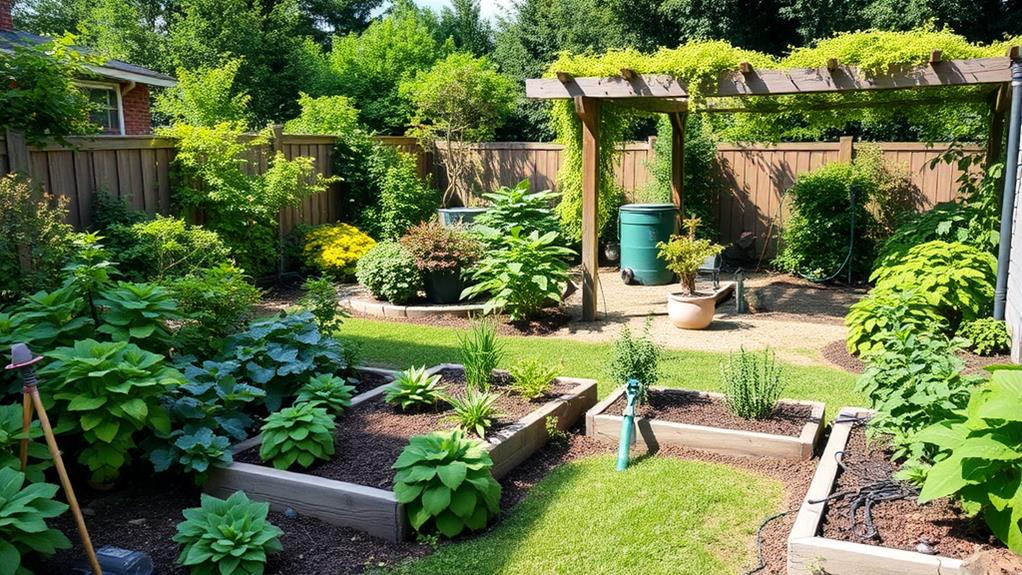
Seasonal planting strategies play a crucial role in creating and maintaining a comfortable microclimate in your backyard throughout the year. By carefully selecting and positioning plants, you can effectively regulate temperature, humidity, and wind patterns in specific areas of your outdoor space.
In summer, deciduous trees strategically placed on the south and west sides of your property provide natural shade, reducing heat buildup and cooling costs. Evergreen trees and shrubs on the north side act as windbreaks, protecting against cold winter winds. For ground cover, use drought-resistant plants in sunny areas to minimize water evaporation and maintain soil moisture.
Consider incorporating seasonal crop rotation in garden beds to maximize sun exposure and soil nutrients. Plant tall crops like corn or sunflowers to create temporary shade for heat-sensitive plants during peak summer months. In cooler seasons, opt for low-growing plants that allow maximum sunlight penetration.
Vertical gardening techniques, such as trellises and green walls, can be employed to create natural cooling barriers and increase plant density without sacrificing ground space. By implementing these seasonal planting strategies, you can effectively manipulate your backyard's microclimate to enhance comfort and enjoyment throughout the year.
Outdoor Structures and Micro-Climates
Outdoor structures play a pivotal role in shaping and enhancing micro-climates within your backyard. Pergolas, arbors, and trellises can provide shade and reduce ambient temperatures, creating cooler zones during hot summers. These structures also offer support for climbing plants, which further contribute to temperature regulation and humidity control.
Retaining walls and raised beds can alter soil conditions and drainage patterns, influencing the micro-climate at ground level. They can create warmer, drier areas ideal for heat-loving plants or cooler, moister environments for shade-tolerant species. Strategic placement of these structures can protect sensitive plants from harsh winds or frost pockets.
Hardscaping elements like patios and walkways absorb and retain heat, potentially extending the growing season for nearby plants. However, they can also create heat islands, necessitating careful planning to balance their effects. Water features, such as ponds or fountains, increase humidity and can cool surrounding areas through evaporation.
Greenhouses and cold frames allow for precise micro-climate control, enabling year-round cultivation of sensitive plants. By incorporating these structures thoughtfully, you can create diverse micro-climates that support a wide range of plant species and outdoor activities throughout the seasons.
Maximizing Natural Lighting
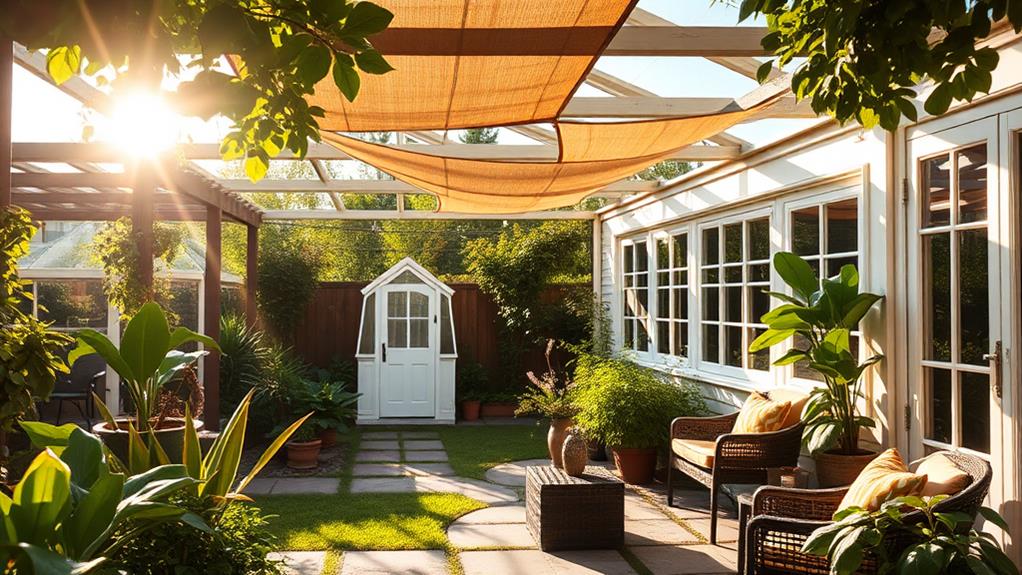
Natural lighting is a key factor in creating comfortable and inviting micro-climates within your backyard. Strategically maximizing sunlight exposure can significantly impact the temperature, ambiance, and usability of outdoor spaces throughout the year. To optimize natural lighting, consider the sun's path across your property and design accordingly.
Incorporate reflective surfaces, such as light-colored pavers or water features, to bounce light into shadier areas. Prune trees and shrubs selectively to allow more sunlight to penetrate dense foliage. Install skylights or solar tubes in covered outdoor structures to bring natural light into otherwise dim spaces. Use translucent materials for pergolas or awnings to filter sunlight while still allowing it to penetrate.
Consider the placement of windows and glass doors in adjacent indoor spaces to create a seamless flow of natural light between your home and backyard. Utilize light-sensing LED outdoor lighting to complement natural light as it fades, ensuring a smooth transition from day to evening. By thoughtfully maximizing natural lighting, you can create diverse micro-climates that cater to different activities and preferences, enhancing the overall comfort and enjoyment of your outdoor living spaces year-round.
Frequently Asked Questions
How Much Does Creating a Backyard Micro-Climate Typically Cost?
Creating a backyard micro-climate varies widely in cost, typically ranging from $5,000 to $50,000+. Factors influencing expenses include size, desired features, materials, and professional services. Simple DIY solutions can be more budget-friendly, while elaborate designs increase costs significantly.
Can Micro-Climate Design Help Reduce Energy Bills for My Home?
In a nutshell, micro-climate design can help reduce energy bills for your home. By strategically placing vegetation, structures, and water features, you can create natural insulation and cooling effects, reducing the need for artificial heating and cooling systems.
Are There Any Potential Negative Effects of Altering My Backyard's Micro-Climate?
Altering your backyard's micro-climate can have potential drawbacks. These may include disrupting local ecosystems, increasing water usage, creating unintended temperature fluctuations, or inadvertently affecting neighboring properties. Careful planning and expert consultation are advisable to mitigate these risks.
How Long Does It Take to Establish a Functional Micro-Climate?
Like tending a garden of Eden, establishing a functional micro-climate is a journey. The timeframe varies, but typically ranges from several months to a few years, depending on the scale, methods employed, and environmental factors involved.
Do Local Zoning Laws Affect Backyard Micro-Climate Renovations?
Local zoning laws can indeed affect backyard micro-climate renovations. Regulations may restrict certain structures, landscaping changes, or water features. It's crucial to consult your local zoning office before undertaking any significant backyard modifications to ensure compliance.
Conclusion
Harnessing backyard micro-climates can transform outdoor spaces into year-round havens of comfort. Like a masterful conductor orchestrating various elements, strategic landscaping, structures, and materials work in harmony to create optimal temperature zones. By leveraging natural features and implementing thoughtful design, homeowners can extend the usability of their outdoor areas, mitigate extreme weather effects, and cultivate diverse ecosystems. This approach not only enhances personal enjoyment but also contributes to sustainable living practices and increased property value.
